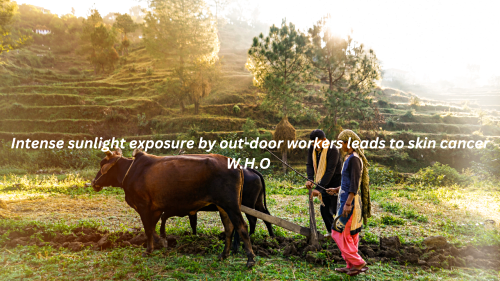Nanda Dulal Bhattacharyya, Haqiquat News, India: WHO and the International Labour Organization (ILO) recently released estimates on how many workers are exposed to intense sunlight at work and how many of them develop non-melanoma skin cancer. How does long exposure to sunlight cause skin cancer? Who is at risk?
Doctor Frank Pega provided a detailed explanation.
Outdoor workers regularly work under the intense sun, sometimes for really long periods of time. The sun emits ultraviolet radiation. When this type of radiation hits skin cells, it can damage their DNA. And that can in turn lead to skin cancer, where these skin cells basically grow uncontrolled. There are two main types of skin cancer. Melanoma is the more deadly type. We looked at non-melanoma, which is the type that is less deadly but much, much more common and a big problem. Non-melanoma skin cancer commonly appears as either a red, firm lump or a flat, scaly patch that doesn’t heal for several weeks, so outdoor workers are at a 60% increased risk compared to indoor workers of having non-melanoma skin cancer. This kind of skin cancer is commonly seen on the face, on the ears, or on the head, but also on the arms and legs, where workers are most exposed to the sun. So, for example, imagine a farmer who plants or harvests rice. That worker will be exposed intensively to the sun for a really long time, and the surface of the water that has flooded the fields that the worker is standing in will reflect back, aggravating the exposure. There are many more people who are working outdoors and who die as a result of non-melanoma skin cancer from this exposure than we could have possibly imagined before we did our estimates. About 1 in 4 workers globally is actually exposed to intense sunlight at work. That’s a staggering 1.6 billion people globally. Most of these are the farmers in the rice fields, the construction workers, and the people who are working in the non-organized sector for long hours under intense sunlight. Outdoor workers who live primarily in low- and middle-income countries and who are often working in the informal economy, where they don’t have any health protections that formal employment would afford them,. One in three non-melanoma skin cancer deaths are actually from working under the sun, so that’s about 19,000 deaths globally each year. If you work outdoors, you’re at a higher risk, and we find that the number of people who die from non-melanoma skin cancer in each region per population is almost equal. So, it’s a global problem. Additionally, it’s a growing problem because the numbers have doubled in the last 20 years. Additionally, governments can provide public health information. This is very important. They can talk about sun safety protocols and protective measures that can be taken. It is also important, as there can be a requirement that workers be provided with protective clothing. They can wear broad-brimmed heads, long-sleeved shirts, and long trousers, and there could also be a provision of sunscreen where it’s effective and deemed possible. Additionally, it’s important that we have functioning health services and systems where skin cancer is prevented and that workers are regularly checked so that skin cancer can be detected early and treated. And finally, but importantly, governments can recognize skin cancer from occupational exposure to the sun as an occupational disease and include it in worker’s compensation schemes.
Referral: # World Health Organization (WHO), as received via official email.
 Dr. Frank Pega is an epidemiologist and health economist focused on environmental and occupational health. Better techniques for systematic review and evidence synthesis are also aided by his area of expertise. He has also researched the effects of interventions on the social determinants of health (especially poverty reduction policies) on health service use and health outcomes.
Dr. Frank Pega is an epidemiologist and health economist focused on environmental and occupational health. Better techniques for systematic review and evidence synthesis are also aided by his area of expertise. He has also researched the effects of interventions on the social determinants of health (especially poverty reduction policies) on health service use and health outcomes.


















Add Comment